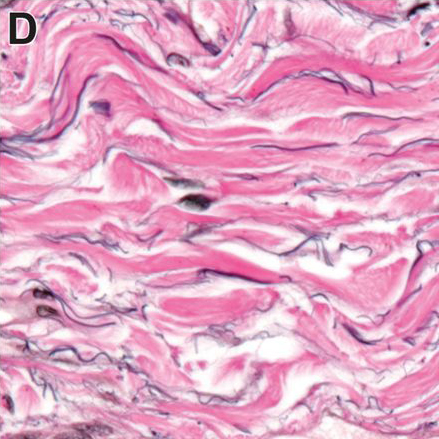Does it give you chills? Make your skin crawl…give you acne?
You may not know what it is that got under your skin but it could be one of the biggest discoveries in medical science over the past year and is a contender as the largest organ in your body.
Already considered by some to be a new organ discovered in our bodies is what is now being called the interstitium by initial researchers.
Only through recent techniques in endoscopy were we able to first observe this potential organ in its natural form and see it for what it really was all along.
What Is An Interstitium?

Researchers calculate the interstitium to be the largest organ in the body by volume, by the way it is wrapped around every organ, including the skin.
The Interstium is approximately 10 liters and comprises about 20 percent of all the fluid in the body.
According to early articles on the subject:
The interstitium is basically a body-wide layer of distendable and compressible fluid-filled structures and connective tissue situated throughout the body, composed of mostly thick collagen bundles, (a strong structural protein found in connective tissues), just under our skin, gut and within the middle layer of every visceral organ.
It also pretty much makes up all of the fascia, a thin mesh of tissue separating every muscle and tissue and surrounding every artery and vein.
Historically this system has been deemed, after the cardiovascular system and the lymphatic system, as the “Third Space”.
(The Lymphatic system is a network that transports fluid containing white blood cells which fight infection throughout the body).
The anatomic or histologic features of this third space have never been documented with any tangible precision.
This third space is actually a network filled with fluid(s) under pressure, that flow directly into, and presumably out of, the lymphatics and lymph nodes on the whole, which is exactly why recognizing and understanding this anatomical feature is so important to medicine and science right now.
According to Wikipedia Entry on the Interstium:
“The non-fluid structure of the interstitium is predominantly composed of collagen types I, III and V, elastin and glycosaminoglycans, such as hyaluronate and proteoglycans that are cross-linked to form a honeycomb-like reticulum.”
These structural components exist both for the general interstitium of the body and within individual organs.
The entry also describes the interstitial fluid as a reservoir and transportation system for nutrients and solutes distributing among organs, cells and capillaries for signaling molecules communicating between cells, and for antigens and cytokines participating in immune regulation.
This space is dynamic and may change in volume and composition during immune responses, and under certain conditions along with the extracellular matrix.
The composition and chemical properties of the interstitial fluid vary among organs and undergo changes in chemical composition during normal function, as well as during body growth, conditions of inflammation and development of diseases, as in heart failure and chronic kidney disease.
The findings of initial researchers can be found on the Scientific Reports Web Site Entry Structure and Distribution of an Unrecognized Interstitium in Human Tissues at Nature.com.
Why Was This Not Discovered Already?

Traditional methods of biological and medical study have in fact obscured the obvious existence of this structure from observation for decades, if not centuries.
This supposed organ has eluded sciences mostly because of the way organ samples are usually processed by dehydration, which uses formaldehyde and chemical fixation to make slides for study.
When prepared for slides in that way the tissue of the Interstitium appears to be densely compacted connective tissue, in which case, the tissue assumes a much different appearance than it does in its natural environment.
Otherwise, if left undisturbed, the tissue is actually not at all compacted, but rather drenched in fluids and, for the most part, is quite malleable.
Scientists and doctors alike already knew of the fluid within tissues and between cells, which is known as “interstitial” fluid.
The Idea that this fluid existed in an organized series of interconnected cavities was never formally recognized or examined.
Only passingly referred to in textbooks as “a space” where the fluids that are not contained in cells is found, and conversely as “dense connective tissue”, the Interstium has recently been discovered to be neither a space nor exactly dense at all.
It is more accurately a fluid-filled reticulated latticework of collagen and other tissues that was collapsed and dehydrated when observed by commonly accepted scientific methods and techniques.
How Was Interstitium First Discovered Then?

About four years ago, two gastroenterologists, David Carr-Locke M.D. and Petros Benias M.D., both skilled endoscopists, (specialists that insert a snakelike tool with a fiber optic camera on the tip, into a living body), were examining living tissues of a bile duct.
At the time they were using a fairly new device known as “probe-based confocal laser endomicroscopy” or pCLE for short, a tool that combines an endoscope, that has a laser and other sensors.
This device is used to reflect a green dye called fluorescein, that is infused into a vein in order to see patterns for miscroscopic analysis.
In the process they recognized a sample of something they had never seen before and were befuddled by it.
They then brought it to a friend of theirs, Neil D. Theise M.D., an anatomic pathologist at Mount Sinai Beth Israel Hospital’s Digestive Disease Division.

They were all good friends through their work which was often complimentary and intertwined within their fields.
The researchers were able to see this reticular pattern – dark bands that separate what one of the researchers called, “…oddly shaped bright spaces.”

After a great deal of consternation when looking at that sample they agreed that they still needed a better look and so they devised and employed another technique in order to examine the tissue sample.
Once they were allowed to remove some similar tissue from a patient undergoing surgery, and instantly freezing the sample, they sliced it into very thin sections where they could observe the cells in their more natural state under a microscope.
(This process is not uncommon, but according Dr. Theise it is seldom carried out on healthy tissue samples, thereby resulting in the scientific oversight).
As a result they realized they were looking at a part of anatomy previously never described directly or scientifically.
What Is The Interstitium For Then?
The interstitium is presumed to primarily protect organs and muscles against movement, tension, torsion, shock and other traumas.
In effect, it is the converse of what was historically observed to be dense and rigid connective tissues.
The interstitium is also a space that is in constant and direct communication with the lymphatic system which may also explain the metastasis and spread of cancer cells beyond the limits of the organ in which they first manifested.
Macrophages, cells that clean up white blood cells, travel freely in this space.
It is the same layer where tattoo pigments are deposited and consumed by cells.
The Interstitium contains a unique and novel cell type as well that mixes features of fibroblasts which make collagen and scar cells, and epithelial cells that more generally line vessels.
These share certain features of mesenchymal stem cells, which are an adult stem cell that can be found in nearly all tissues, but has remained mysterious in origin.
Other possible functions for this supposed organ are being widely investigated.
How Do We Know The Interstitium Is An Organ?
Frankly, it’s not quite an organ yet, not officially anyway.
The accepted definition of an organ is, oddly enough, not a very precise one.
General requirements are that it have a primary tissue or parenchyma, as well as sporadic tissue known as stroma, such as nerves, vessels, connective tissue, etc.
Regardless of size, organs form tissues that are organized to perform specific functions in a body.
Simply put, they are the discernible component parts that make up a complete organism.
However, in order to be officially designated an organ, consensus will have to be reached among many fields of medicine and science.
In the meantime, Dr. Michael Nathanson, chief of the digestive diseases section at Yale University School of Medicine, is on the record by way of an article on LiveScience, who considers the research to be, “…a completely new concept,” going on to say, “From the evidence they presented it’s quite possible they’re correct”.
The research team’s findings are consistent with what Nathanson and colleagues noted in a published study back in in 2011, and he was pleased that they were able to substantiate his impression of a network of dark fibers that had confounded them years earlier.
That such a network existed, and that the discovery team went on to define it further allows questions to be asked that no one knew to think of before.
What Does It Mean Now That We Know It’s There?
According to Dr. Theise, in an experiencelife.com interview, “One can’t understand the mechanical properties of any tissue without understanding the lubricating and shock-absorber potential of the interstitium.”
Dr. Nathason wonders if this area could become altered, or play a role, in disease or its pathology?
The novel cell types are being investigated for their role in not yet identified sources of scaring in diseases like idiopathic fribrosis and scleroderma.
Acupuncture, pulse diagnosis from Eastern medicine and myofascial-release therapy are contenders that may find some mechanistic explanations in this interstitial structure and in other properties of the body upon further study.
Already known properties of collagen matrices are that they are conductors of electricity and are also known to actually create electricity when bent.
With the Interstitium in constant movement, through breathing, pulse, peristalsis and general activity, electrical impulses and communications through this collagen latticed network could potentially occur under pressure, release or by way of induction through acupuncture needles.
Along such lines of thought, the same could be said of sound waves and their propagation along meridian channels not previously observable without the insight of this new perspective.
Health And Beauty, Beyond Skin Deep
The implications of such a discovery obviously go well beyond the surface…how this can be used and interpreted from liposuction to cool sculpting to cosmetic surgery and surface treatment regimens may be dramatically scrutinized and adapted accordingly.
Recognizing first and foremost the applications of collagen, hyaluronic acids, along with other such superficial remedies will have a spotlight put on them while being put under the microscope.
Surely in the long run, that being after the scientific method and FDA clearance plays out, many new discoveries and breakthroughs will be made available and should be looked forward to with much anticipation.
Interstitial Conclusions
Regardless if the Interstitium is accepted as a new bodily organ any time soon, there is consolation in knowing several things from this epiphany within modern sciences.
Firstly, science is not always exact. Whatever is known is just a well-guarded representation of what science currently thinks it knows.
Secondly, regardless of the first point, there are those in the fields of science willing to push the envelope into new understandings of that which was presumed to be already understood.
And finally, there is still room to expand science and medicine within the confines of our own body, if at least to explain what we knew already but had no way of representing before.
So now that you know you have one, how you use your interstitium and your knowledge of it, is entirely up to you. Just don’t go spreading it all over the place as that would be wrong on so many levels.
Additional details came from: thedailybeast.com


